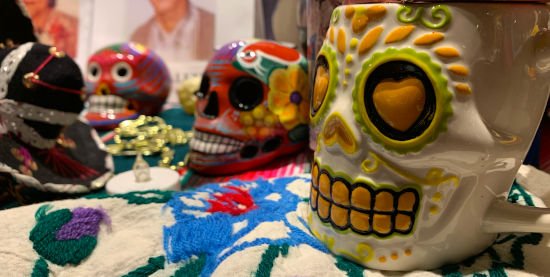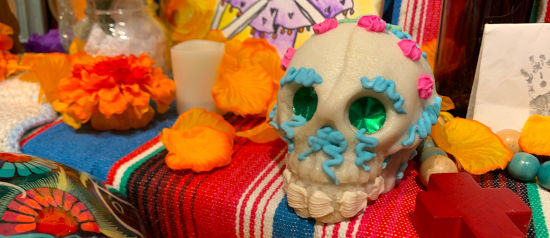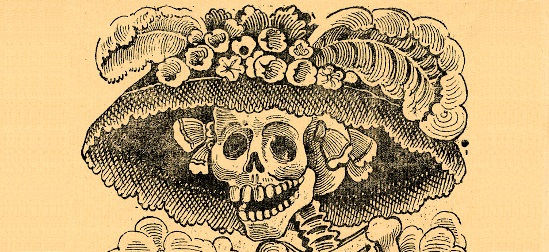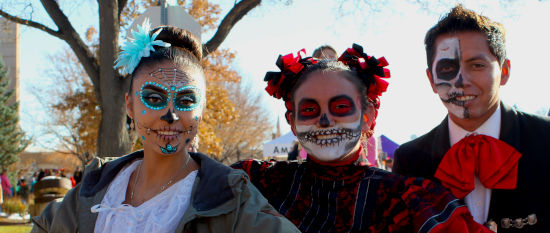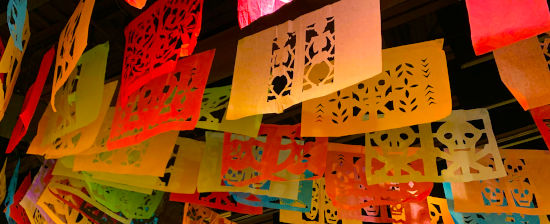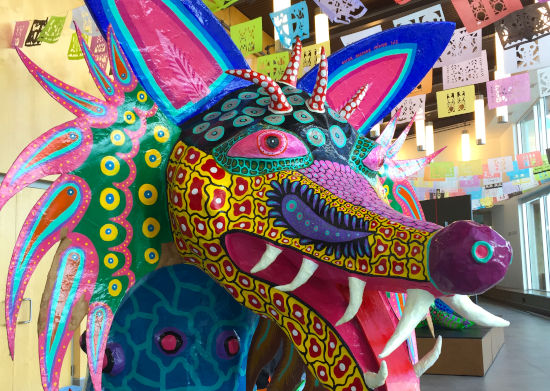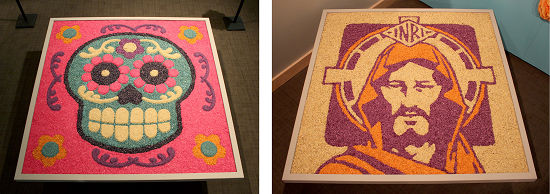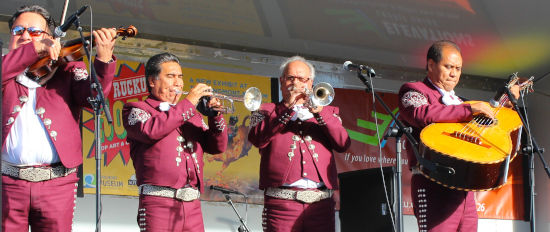Music, Arts, and Crafts
Day of the Dead is a unique celebration of life and death, where mourning is exchanged for celebration. Día de los Muertos art and decor, instantly recognized by its vibrant colors and intricate designs, is an important part of the celebration.
Skeletons and Skulls
The most familiar decorative elements of Day of the Dead are calacas and calaveras (skeletons and skulls), which appear everywhere during the holiday. The use of skulls symbolizes death and rebirth. The skulls can be made out of papier-mâché, sugar, clay, or painted on the faces of revelers.
Skull imagery has a long history dating back to the traditions of pre-Columbian civilizations. It is believed that the Aztecs worshipped a goddess of death, Mictecacihuatl, who allegedly protected their departed loved ones, helping them into the next stages. Mictecacihuatl was often represented as a skeleton, adorned with a crown of flowers and skulls.
Another motif that may have influenced calavera imagery is the European art known as Danse Macabre. Often featuring dancing skeletons, this artwork was meant to represent the inevitability of death. It is probably that the Danse Macabre motifs were brought over by Spanish missionaries and later fused with Indigenous skull imagery.
Sugar Skulls
Alfeñiques (sugar skulls) are decorated and placed on the ofrendas of loved ones. Artisans mold the sugar mixture (made of eggs, sugar, lemon,and plant extracts) into the shape of a skull to later decorate for display. Be aware that many of these sugar skull candies are decorated with non-edible sequins, rhinestones, and other items that should not be eaten.
The colors used are significant:
- Red is used to represent our blood
- Orange represents the sun
- Yellow represents the Mexican marigold (and in turn death itself)
- Purple is pain (though in other cultures, it could also be richness and royalty)
- Pink and white are hope, purity, and celebration
- Black represents the Land of the Dead
Names are written on skulls to honor a deceased loved one, or to save a place in the underworld for someone living. Putting the name on someone living on a sugar skull isn’t foreboding, it just means that person is important to you and you are saving them a spot in the next life!
Catrina Calavera
La Calavera Catrina is a famous etching by Jose Guadalupe Posada, a controversial and political cartoonist in the early 1900s. It has become an icon in Mexico representing the Día De Los Muertos. Through La Catrina, a skeleton dressed in a very expensive outfit, Posada indicated that death applies to all of us, including the rich. Posada’s drawings would make fun of everyday situations, often taking aim at the excesses of the upper classes, and satirize political figures.
La Catrina can be seen in various holiday decorations, such as papier-mâché figurines, wood carvings, and pottery. Most famously, the character is featured in Diego Rivera’s mural “Dream of a Sunday Afternoon in the Alameda Central.” She has come to represent the Day of the Dead and the images of her and other skeletons are now an art form in Mexico.
How-To Video
Join us as we lead you in a relief printing craft.
Face Painting
During Day of the Dead, people paint their faces as incredibly beautiful skulls. The skull face paint represents their ancestors who have passed on and celebrates the beauty and necessity of death.
How-To Video
Papel picado
Made out of colorful tissue paper, papel picado (or “chiseled paper“) is a flag-like folk art. It evolved from a Pre-Columbian version made out of tree bark, which the Aztecs used to adorn religious sites. “The holes allow a way for souls to travel through and visit,” López Fértor says. It’s also believed that the delicate nature of the paper is symbolic of the fragility of life.
Paper Flowers
Flor de Muerto, bright orange and yellow marigolds, are intended to cheer up the dead with their brilliant colors and sweet scent. They serve as the pathway to guide spirits to their ofrendas. Coronas de flores (Flower crowns) are often placed on graves after burial, with new coronas being purchased each Day of the Dead to replace the old ones. Celebrants often make large colorful tissue paper flowers in bright colors to serve as Flor de Muerto.
Alebrijes
Alebrijes (animal figures) are not specific to Día de los Muertos but their brightly colored dots and exaggerated features make their presence commonplace in Day of the Dead celebrations. Alebrijes are stylized animals, often compiled from different animals, brought to life with vibrant colors.
Artist Pedro Linares created the first alebrijes in the 1930’s and his depictions melded with Aztec mythology. Alebrijes became sacred entities that could pass among the living and in the land of the dead. They were seen as guides between the living and the dead.
Depictions of these animals are carved from copal wood or made out of papier-mâché and decorated with acrylic paint.
How-To Video
Join us for a demo of an Alebrije craft.
Tapete de arena
Tapete de arena (carpets of sand) are elaborate patterns of colorful sawdust line the entryway of the altar and serve as a path for the dead. Made from dyed sawdust, flowers, seeds, corn, beans, salt, and ash, sometimes they span the length of a block and can take a dozen celebrants the whole day to create. Chalk drawings lay out the design, and stencils are used to create elaborate designs.
Common design elements include crosses, flowers, skulls, swirls, and patterns. Once complete, people will line place lit candles around the carpet to serve as a guide to spirits.
Music
Music plays an important part in Day of the Dead celebrations. On November 2 musicians will wander the graveyard and families can hire them while everyone is celebrating around the tomb.
The music can be fast, similar to mariachi music, with a beat that is perfect for dancing and celebrating. Or it can be slow and soulful, like Canto Cardenche, sharing stories of the past. It can be sacred, secular, ritualistic, or celebratory.
With a favorite song, you can call back a departed soul to celebrate with a shared dance. By sharing a remembrance through lyrics, you can feel like that person is still here. When you get into the spirit of the song, you get lost in the music and lost in remembering. Plus everything is more of celebration with music!
Here are some examples of the music styles that would be perfect for your Day of the Dead playlist:
- Calaverita (La Santa Cecilia)
- La Culebra y La Negra (Mariachi Vargas de Tecalitlán con el Ballet Folklorico del Instituto Tecnologico de La Paz)
- La Llorona (Lila Downs & Mariachi Juvenil de Tecalitlan) – This version of “La Llorona” comes from the soundtrack of Frida, the 2002 film depicting the life of renowned surrealist Mexican painter Frida Kahlo.
- La Noche Llegará (Los Cardencheros de Sapioriz) – Canto Cardenche is a music style that has been passed down from generation to generation since the 1930s but is currently in danger of extinction. Stirring, soulful and striking, the a cappella tradition recalls the slave spirituals of the United States. The music is now only practiced only in one tiny Mexican town in Durango. The only stable and surviving cardenche group left in the world are Los Cardencheros de Sapioriz, a three-piece hailing from Sapioriz, the town mentioned in their name.
- Son de la Bruja (Jose Luis Hurtado)
Further Exploration
Visit Day of the Dead Resources to find library books for kids and adults, downloadable/printable resources, and additional websites to help you dig deeper into the origins and history of this magical celebration.
